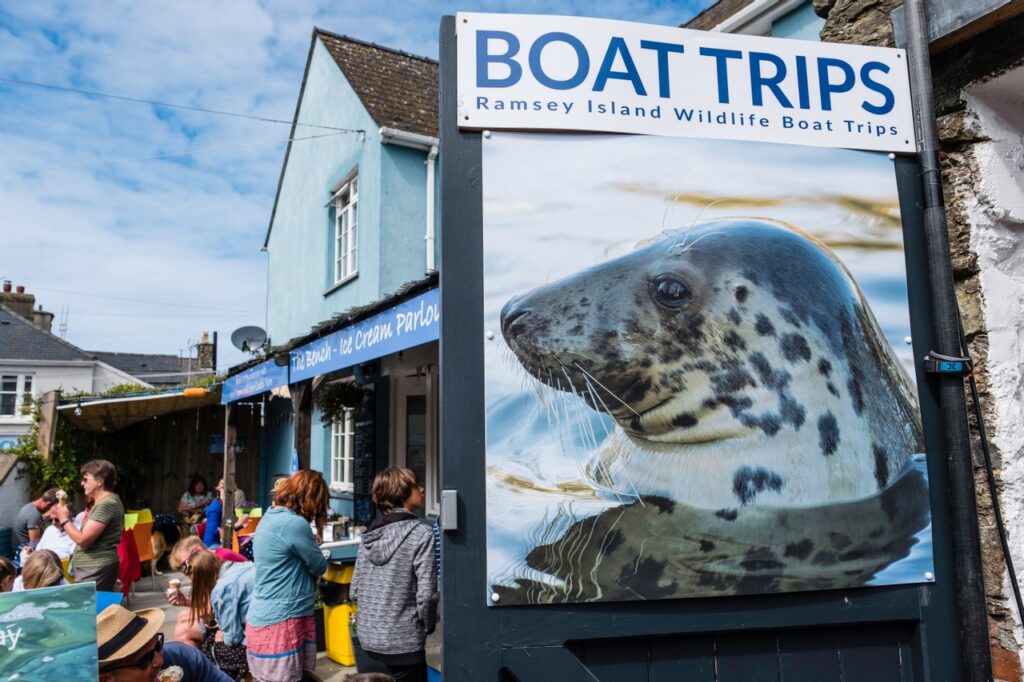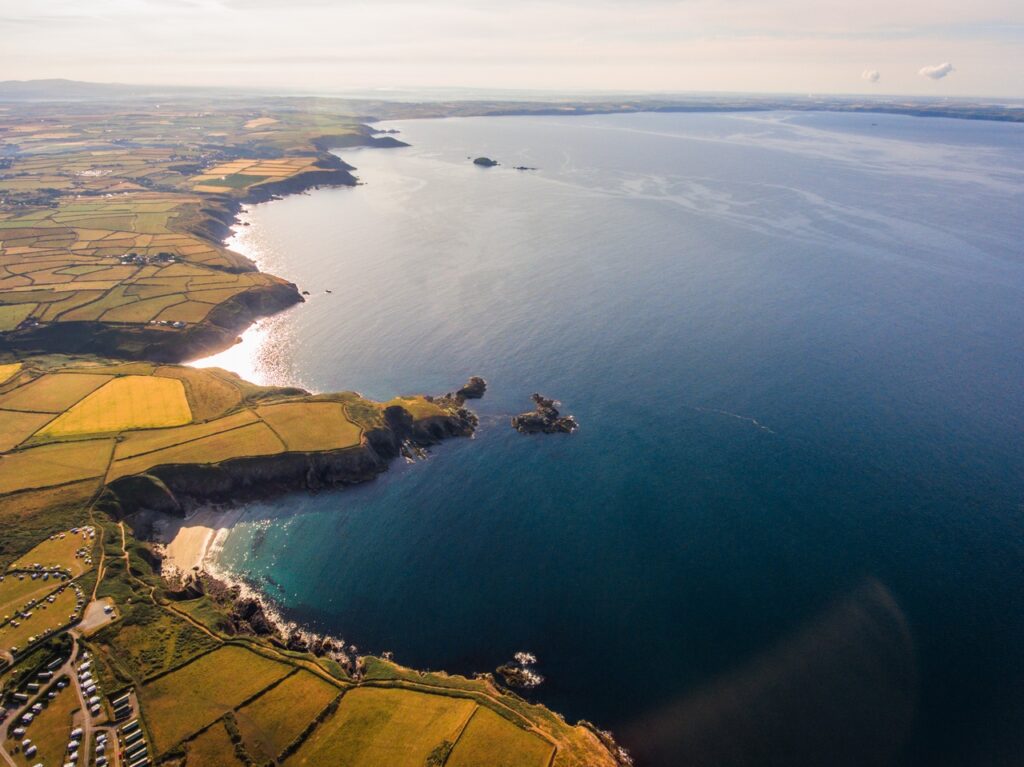St Davids

NAMED after the patron saint of Wales, St Davids is the smallest city in Britain and is home to a wealth of history. From Celtic roots to a place of pilgrimage, the coastal city has been a sought-after spot for thousands of years.
City status was awarded in 1995, although St Davids has a village-size population of only around 1,600. St Davids and its peninsula was designated as a conservation area by the Pembrokeshire Coast National Park in 1972.
People have lived in St Davids and the wider area for at least 6,000 years, with reminders of prehistoric ancestors, like the remains of Iron Age forts, ancient field patterns, enclosures and defensive banks, dotted across the landscape.
St David is believed to have been born in AD 500 to St Non, in the area just south of the city and later baptised in Porth Clais. David had a religious upbringing and upon reaching adulthood was ordained a priest, working firstly in Wales before travelling to England, Brittany and even Jerusalem.
He founded the monastery, where St Davids Cathedral sits today, in AD 550 – although being so close to the sea meant the structure was prone to Viking attacks. The cathedral that now stands proud in the city dates back to the 12th Century and is the final resting place of David himself.
He was made the patron saint of Wales in the 12th Century. Pope Calixtus II stated that David’s shrine was so important that two pilgrimages to St David’s were equivalent to one to Rome and three were equivalent to one to Jerusalem.
As such, his shrine has become a popular destination with pilgrims from far and wide.
The St Davids Cross, a well-known landmark in the centre of St Davids, is a medieval preaching cross. The shaft is original, the head and six-step base being more modern. It’s opposite the National Trust Visitor Centre and shop.
The monument is one of many along an historic route of pilgrimage to the cathedral. The cathedral itself was built with stone from the cliffs at Caerbwdy on the Solva Coast.
The Monks’ Dyke, or Ffos y Mynach, is thought to mark the limit monks and priests could move from St Davids Cathedral. It runs across the St Davids peninsula, joining together several National Trust places, from Morfa Common in the south, Dowrog Common near the city and Pen Beri on the north coast.
It is possible to retrace much of it with the help of an Ordnance Survey map, on a combination of footpaths and minor roads.
The peninsula is a fantastic centre for family holidays, splendid sandy beaches with accommodation to match, and all linked by Pembrokeshire’s award-winning National Park coastal footpath; outdoors attractions here are second to none – walking, surfing, canoeing, coasteering, climbing, yachting and fishing – everything is possible in this amazing place.

Around the shores and islands is some of the most remarkable wildlife to be found anywhere: seals, dolphins and porpoises, the amazing bird life of Ramsey Island managed by the RSPB, and with every year a profusion of spring flowers.
Everything is available for holiday-makers’ needs – top accommodation, family-owned hotels, first-class bed and breakfasts, world-class self-catering cottages and superbly-situated caravan and camping sites, not to mention excellently-run local boat companies.
The streets are alive with excellent shops, galleries, pubs and restaurants. In March, St Davids celebrates Wales’s patron saint, when gourmets can enjoy the Really Wild country food fair, and in summer concerts and plays fill the evenings, including the world-renowned annual St Davids Cathedral Festival.
The nearest railway station is either Fishguard or Haverfordwest. Ongoing bus services to St Davids run several times a day.
The coastline is well served by the Puffin Shuttle, which heads down around St Brides Bay and the Strumble Shuttle, which connects various points on the coast between St Davids and Fishguard. Both services are ideal for anyone walking the Pembrokeshire Coast Path. Services usually run in the morning to drop you off at your start point and then return in the afternoon to pick you up.
Located in the National Park Information Centre, Oriel y Parc Gallery boasts a class A landscape gallery, exhibiting art and artefacts from the collection of Amgueddfa Cymru – National Museum Wales. Using objects from the art, natural history and industry collections, visitors are able to view a regularly changing exhibition programme.
The brooding gothic ruins of the Bishop’s Palace lie on the opposite bank of the river from the cathedral and provide a suitably dramatic backdrop for open air theatre performances in the summer. Bishop Henry de Gower’s legacy consists of the simpler east range, his private domain, and the grander south range, built for banqueting in the great hall.
The welcoming Pebbles Yard Gallery and Espresso Bar is the ideal spot to grab a bite to eat and take a break from exploring. Head inside to see works from local wildlife, Pembrokeshire’s largest collection of jewellery and a range of changing exhibits from contemporary artists and designers.
Boat trips to the wild offshore islands of Ramsey, Grassholm, Skomer and Skokholm offer an opportunity to get close to the sea life that call this rugged landscape home. Catch a glimpse of puffins, gannets, porpoises, dolphins and whales and choose a 15-minute island hop or a leisurely cruise depending on how sturdy your sea legs are.

Ramsey Island is a beautiful, unspoilt RSPB Nature Reserve with a large variety of visiting and breeding birds. Boasting some of the highest sea cliffs in Wales and spectacular breeding colonies of nesting seabirds, Ramsey is also home to one of the UK’s largest grey seal colonies and from September to December seal pups are on every beach.
The island is awash with colour from May to September, with bluebells, then pink thrift and purple heather. There is a small shop on the island and refreshments are available.
Caerfai, the nearest beach to historic St Davids, has long been popular for bathing with residents and visitors alike. At high tide it consists entirely of rocks and boulders, but sand is revealed as the tide goes out. The sheltered bay is surrounded by impressive but unstable sandstone cliffs with plenty of evidence of rock falls. There are several caves to explore, as well as interesting rock pools.
One of the most popular beaches in Pembrokeshire, Whitesands is a large west-facing expanse of sand in a magnificent setting, with views of Ramsey Island and several smaller islets. Ideal for sandcastle building, paddling and swimming, the beach is also popular with surfers, windsurfers, kayakers, divers and anglers.
Traces of a 6th Century chapel to St Patrick are buried beneath the dunes behind the beach. The coastline here is rich in wildlife. A variety of sea birds, seals and porpoises are often spotted close to the shore. Whitesands is a good base for short walks along the Pembrokeshire Coast Path or to the summit of nearby Carn Llidi, from where there are superb views.

In the 18th and 19th centuries, Porthgain was a flourishing seaport exporting slate and shale. Now it is a quaint harbour occupied with small fishing boats. Don’t miss the opportunity to buy crab fresh off the boat when the fishermen return. Walk along the coast path to the amazing Blue Lagoon at Abereiddy.
Famous for its unnaturally deep blue water, the Blue Lagoon, is a beautifully-sited flooded slate quarry, including past ruined quarry buildings and slate-workers’ cottages. Popular activities here include snorkeling, diving and kayaking and children enjoy hunting for tiny fossils, known as graptolites which may be found on the beach.
St Justinians is a tranquil, peaceful harbour save for the sound of sea and birds. But it belies its reputation. The waters of St Davids and Ramsey Island are home to the vicious Bishops and Clerks rocks and reefs. Combined with exceptional tides, the area has caused many a ship to founder. Visit the new St Davids Lifeboat station and find out about the history of the lifeboat and the 450 lives that it has saved. We recommend a donation to the RNLI too.
Royal St Davids City Golf Club, established in 1894, is a traditional links course overlooking White Sands Bay. It provides a challenging test of golf in a breathtaking setting in the most beautiful and scenic part of the area, dominated by the brooding presence of Harlech Castle. The undulating fairways and fast, true greens are all that would be expected of a championship links course.
The Club has hosted national and international tournaments, including the Ladies European Tour and the European Seniors Tour, with five past Open and Masters Champions having won events at the course.
Adventure activities for all ages and abilities – coasteering, surfing, paddle boarding, sea kayaking and rock climbing – are available in the heart of St Davids with the UK’s only B Corp adventure operator, TYF Adventure and Coasteering.
Since pioneering coasteering in 1986 TYF have taken many thousands of customers out to explore the Pembrokeshire Coast, and are the world’s most experienced operator. Scramble around pristine cliffs, swim between rocks and jump from land to sea with wildlife-trained guides.

St Davids is lucky to have two wonderful Pembrokeshire woollen mills on its doorstep – Melin Tregwynt and Solva Woollen Mill. Both have been working mills since the 17th Century. Beautiful blankets, throws and cushions made the traditional way, are available to buy and cwtch under on a winter’s day.
If you’re looking for somewhere to stay in St Davids, there are plenty of accommodation options. Choose from contemporary town centre apartments overlooking the cathedral, luxury self-catering cottages overlooking the coast, award-winning hotels and modern youth hostels.
(sources include National Trust, Visit Pembrokeshire, stdavidsinfo.org, Visit Wales, Historic UK, West Wales Holiday Cottages, St Davids Escapes)
Back to HOME PAGE